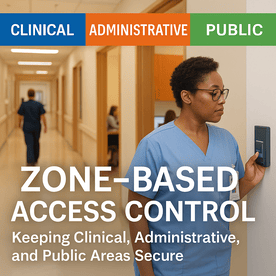
Hospitals are busy, dynamic environments where hundreds—sometimes thousands—of people move through hallways, patient rooms, offices, and restricted spaces every day. From patients and visitors to staff, contractors, and vendors, the flow of people is constant.
While open access is vital for care delivery, uncontrolled movement in sensitive areas creates risks—including patient safety incidents, data breaches, medication theft, and even workplace violence.
This is where zone-based access control becomes essential. By segmenting a facility into access zones, hospitals can manage who can enter specific areas, when they can enter, and under what conditions—without creating unnecessary bottlenecks in daily operations.
k
k
What Is Zone-Based Access Control?
Zone-based access control is the practice of dividing a facility into distinct security zones based on function, sensitivity, and risk level. Each zone has its own access permissions, security monitoring, and credential requirements.
In healthcare settings, this often means separating:
-
Public Zones – Lobbies, waiting areas, public hallways
-
Clinical Zones – Patient rooms, treatment areas, nurse stations
-
Restricted Zones – Operating rooms, pharmacy storage, lab areas
-
Administrative Zones – Offices, HR, IT server rooms
-
Critical Infrastructure Zones – Electrical rooms, HVAC control, data centers
Instead of granting “all access” to staff, permissions are tailored to the employee’s role, reducing opportunities for unauthorized entry.
k
k
Why Hospitals Need Zone-Based Access
A single open-access building poses multiple security challenges. Without zoning:
-
Sensitive areas can be accessed by anyone with a badge—even if they have no business being there.
-
Patient privacy can be compromised, violating HIPAA compliance.
-
Valuable assets and medications are vulnerable to theft or diversion.
-
Security investigations become harder because badge activity is too broad to pinpoint.
By implementing zones, hospitals limit movement to only what’s necessary—supporting both operational efficiency and patient safety.
k
k
How Zone-Based Access Control Works in Practice
1. Role-Based Credentials
Employees, contractors, and vendors are assigned access levels based on their job functions. For example:
-
Nurses: Access to clinical areas, nurse stations, and storage rooms in assigned departments
-
IT Staff: Access to server rooms, infrastructure zones, and administrative areas
-
Cleaning Staff: Limited access to clinical and public spaces during specific shifts
k
k
2. Layered Access Points
Access control is stacked—meaning a staff member might have to pass through two or more credentialed checkpoints to reach high-security zones like the OR or pharmacy.
k
k
3. Time-Restricted Permissions
Some zones can be time-bound—allowing access only during scheduled shifts. This helps prevent after-hours wandering or unauthorized entry.
k
k
4. Integration with Surveillance and Alerts
When access events are logged, they can automatically trigger video surveillance recordings for verification. Suspicious access attempts can send real-time alerts to security staff.
k
k
Real-World Example of Zone-Based Access
In a large hospital, a pharmacy theft incident prompted leadership to adopt zone-based access:
-
The pharmacy became its own restricted zone, accessible only to pharmacists and pharmacy techs.
-
A double-door vestibule was installed with badge readers at both entry points.
-
Attempted access by unauthorized staff triggered silent alerts and video capture.
Within months, incidents dropped to zero—and pharmacy inventory discrepancies were eliminated.
k
k
Benefits of Zone-Based Access Control for Healthcare Facilities
| Benefit | Impact on Hospital Operations |
|---|---|
| Improved Patient Safety | Prevents unauthorized entry into patient treatment areas |
| Regulatory Compliance | Supports HIPAA, Joint Commission, and DEA controlled substance rules |
| Reduced Theft & Diversion | Limits access to high-value medications and equipment |
| Operational Efficiency | Ensures staff have access only where needed |
| Incident Investigations | Simplifies reviewing access logs and camera footage |
Best Practices for Implementing Zone-Based Access
-
Conduct a Security Risk Assessment to identify high-risk areas.
-
Work with Department Leaders to define access requirements.
-
Integrate Access Control with Surveillance for better monitoring.
-
Train Staff on policies, reporting suspicious activity, and compliance responsibilities.
-
Review Access Logs Regularly to ensure permissions stay up-to-date.
k
k
Conclusion: Smarter Access Means Safer Hospitals
Zone-based access control allows hospitals to strike the right balance between security and accessibility. By segmenting areas, assigning access based on roles, and integrating real-time monitoring, healthcare facilities can protect patients, safeguard assets, and maintain compliance—without slowing down care.
Talk to SSP about designing a zone-based access control strategy that works for your facility’s size, workflow, and compliance needs.


